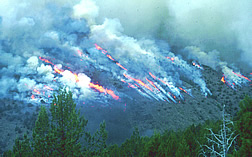This page has been archived and is being provided for reference purposes only. The page is no longer being updated, and therefore, links on the page may be invalid.
|
|
Return of the Native: ARS Scientists Stimulate Growth of Native Aspen Trees
By Laura McGinnisSeptember 30, 2005
Methods to restore aspen woodlands being overrun by conifers are being studied by Agricultural Research Service (ARS) scientists and cooperators in Oregon.
With its fiery fall foliage, quaking aspen has thrilled generations of leaf watchers. But it's more than just a pretty face: This delightful deciduous tree is an influential member of its environmental community. Unfortunately, aspens are rapidly losing ground to coniferous woodlands in an arboreal turf war.
Like the mythical phoenix, aspens rely on fire to promote regeneration. New shoots arise from parent root systems in response to disturbances. But as fire suppression has increased, other species have begun to invade the aspen territory, according to rangeland scientist Jon Bates at the ARS Range and Meadows Forage Management Research Unit in Burns, OR. He is cooperating with the Bureau of Land Management and private landowners to investigate the effects of cutting and burning invading conifers on aspen regeneration.
Bates wanted to compare the effects of burning in autumn versus burning in spring. Within selected aspen groves, he cut a third of the invading juniper trees, then set them ablaze. Burning in autumn, he discovered, stimulated the aspen and removed all remaining juniper. It also removed almost all ground cover, initially. Spring burning partially stimulated the aspen, and only removed 90 percent of the mature junipers and 50 percent of the seedlings, while promoting rapid recovery of the "understory"--the species growing under the trees.
Aspen groves support many wildlife species. They have more diverse and productive understories than conifers, providing more forage for livestock. In addition, they generally release more water into the watershed, aiding anglers and agronomists alike. Bates' research proves that spring and autumn burning successfully promote aspen growth, with different effects on surrounding vegetation. Public land managers and private land owners can choose either option, depending on their objectives.
ARS is the U.S. Department of Agriculture's chief scientific research agency.

